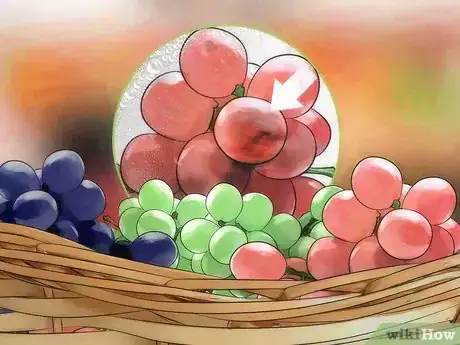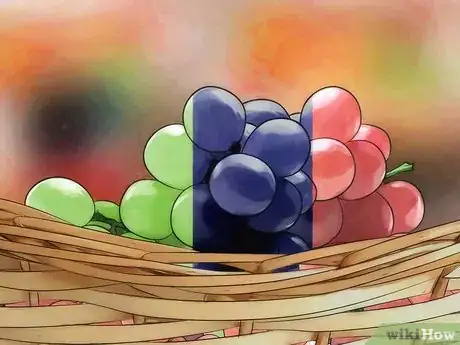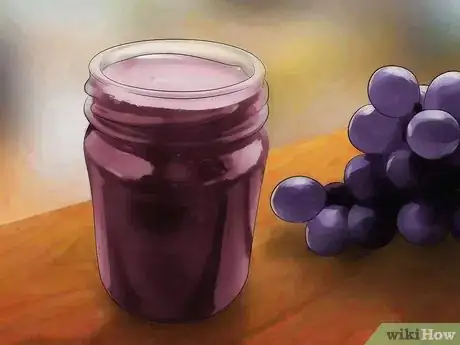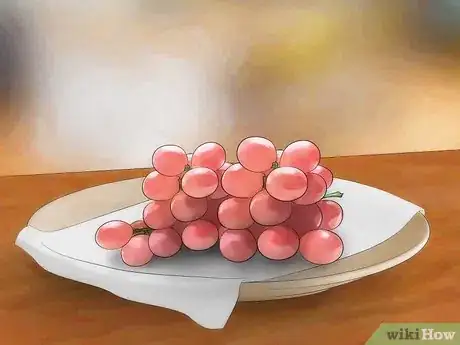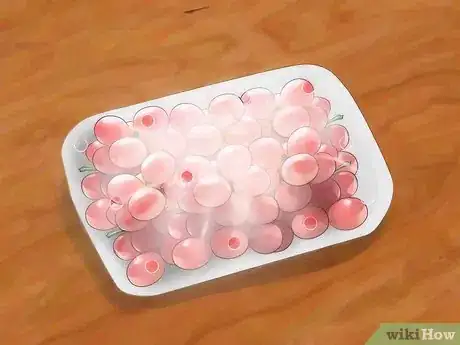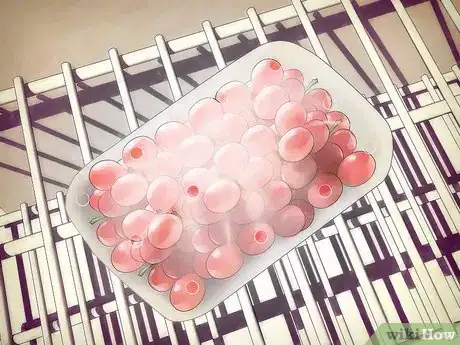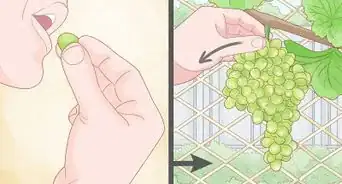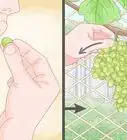This article was co-authored by wikiHow Staff. Our trained team of editors and researchers validate articles for accuracy and comprehensiveness. wikiHow's Content Management Team carefully monitors the work from our editorial staff to ensure that each article is backed by trusted research and meets our high quality standards.
This article has been viewed 61,663 times.
Learn more...
A grape is a popular and refreshing fruit, which can be eaten raw or processed in a variety of other food products such as jam, juice, wine, raisins, or grape seed oil.[1] Grapes come in different varieties, with the fruit’s most common colors being green, red, and black. Different varieties ripen at different times, depending on where they are grown. Learning how to select grapes can help you find ripe, fresh fruit to suit all of your culinary needs.
Steps
Assessing Whether Grapes Are Ripe and Healthy
-
1Examine the grape texture. Ripe, healthy grapes should be firm and plump on all sides. If a grape is shriveled where the stem meets the fruit or if there are any signs of moldiness, the grapes are not in good condition. You should also avoid grapes that have excess moisture inside the bag, as this is often a sign that the grapes may be susceptible to mold or rot.
-
2Look at the skin on the grapes. The best grapes will have a healthy shade to the skin. Ripe red grapes should have a dark purple hue, as any signs of green indicate that red grapes are not yet ripe. Ripe black grapes should have a full, rich shade of bluish-black, and green grapes should have a yellowish hue.
- In addition to skin tone, healthy grapes should also have a light silver-colored dusting on the skin called bloom.
- Bloom is commonly mistaken for dirt, but it's actually the plant's way of protecting the fruit from drying out or rotting.[2]
Advertisement -
3Check the stem. The stem of a healthy grape cluster should be green and flexible. If the stem is brown or brittle, the grapes may be old or poorly-grown.[3] You should also make sure that the majority of grapes are securely attached to the stem, as this is considered a sign of healthy, well-grown grapes.
-
4Determine if grapes are in season. The climate in which a grape variety is grown will affect when it ripens and how it tastes. The majority of each type of grape (green, red, and black) generally tend to ripen in the same part of the growing season. There are exceptions, of course, and each type's growing season may vary somewhat, depending on where they are grown.
- Green grapes typically ripen in the middle of the growing season. Ripe green grapes should have a yellowish hue to the skin.
- Red grapes tend to ripen fairly early in the growing season, though there are some exceptions. Ripe red grapes should have a dark reddish-purplish hue without any signs of green.
- Black grapes generally ripen in the early to middle part of the growing season. Ripe black grapes should have a rich violet hue to the skin.
Choosing a Grape Variety
-
1Choose a slightly sweeter grape for eating. Grapes can vary significantly in sweetness from one type to another. In general, though, most people choose sweeter grapes if they're being used as table grapes (for eating as they are).[4]
- Canadice, Concord, Himrod, Mars, Neptune, Niagara, Reliance, and Thompson Seedless are among the most commonly-purchased table grapes found in stores.
-
2Select a very sweet or tart grape for making jam. When choosing grapes to make jam with, you may want to opt for a grape that's sweeter than what you would pick for table eating. For this reason, many jam makers prefer muscadine grapes for a sweeter jam, though others do prefer a more tart grape for a more balanced jam profile.[5]
- Beta grapes and Chambourcin grapes make a good tart jam, while something more saccharin like Van Buren grapes would be ideal for a sweeter jam.
- Most wine grapes can also be used for making juice and jam, and they tend to range from very dry to very sweet. Which type you choose will depend largely on your taste preferences.
-
3Pick a wine grape that suits your tastes. Wine grapes (which are also frequently used for making juice and jam) range dramatically in flavor, from very dry to very sweet. Which grape you choose to make wine or juice with will depend entirely on what flavor profile you're looking for.[6]
- Cayuga, Chardonel, Moore's Diamond, and Riesling grapes are all good choices for a dry wine or juice.
- Canadice, Catawba, Jupiter, LaCrosse, and Muscat grapes will produce a sweeter wine or juice.
- Some people like both sweet and dry wines, depending on the meal that wine is being served with. Try experimenting with different types of grapes and different flavor profiles to find a grape that works best for your needs.
Cleaning and Storing Grapes at Home
-
1Store grapes without washing them. It's important to wash grapes before eating them to ensure that you remove any bacteria and pesticides. However, storing wet grapes is more likely to lead to mold and rot. Instead of washing the whole bag, it's best to just remove however many grapes you need for one serving and wash only those grapes.
- When you do wash grapes, you can simply rinse them under clean, cool water from the faucet.
- Place washed grapes on a plate with paper towels to prevent water from spilling as you snack on them.
-
2Keep grapes in their original packaging. The bags that grapes are sold in are specially designed to protect the fruit while simultaneously allowing the grapes to breathe. These ventilation holes also allow any moisture to escape so that the grapes do not get moldy or go bad as quickly as they would in an unventilated bag.
- While sealable sandwich bags are great for storing some foods, it's best to store grapes in a bag that lets the fruit breathe unless you plan on freezing them.
-
3Chill grapes in the refrigerator or freezer. Grapes keep best in a cool to cold environment. If you're storing them for a short period of time, keep grapes in the back of the refrigerator and set the temperature to around 30 to 32 degrees Fahrenheit (-1 to 0 degrees Celsius). If you're planning on using frozen grapes in a smoothie or simply want to store them for prolonged periods of time, you can store them in the freezer. Simply wash, dry, and de-stem the grapes, and they're ready for the freezer.
Community Q&A
-
QuestionWhen do grapes ripen?
 Community AnswerThey are typically ripe when they look like juicy grapes and this is usually late summer, early fall. They go bad really quickly so pick them quickly once they ripen. It is why ancient Romans made wine.
Community AnswerThey are typically ripe when they look like juicy grapes and this is usually late summer, early fall. They go bad really quickly so pick them quickly once they ripen. It is why ancient Romans made wine. -
QuestionI just bought red seedless grapes, but they are green or half green. They taste good and are sweet, but are they OK to eat?
 Community AnswerYes. It's just the color.
Community AnswerYes. It's just the color. -
QuestionAre grapes suitable for vegans?
 Maggie PetersonCommunity AnswerYes, grapes are a suitable food for vegans because they do not contain animal products.
Maggie PetersonCommunity AnswerYes, grapes are a suitable food for vegans because they do not contain animal products.
References
- ↑ https://www.sciencedaily.com/terms/grape.htm
- ↑ https://www.woolworths.com.au/Shop/Discover/fresh/fresh-market-update?name=seasonality-grapes-v2&cardId=1254
- ↑ https://www.woolworths.com.au/Shop/Discover/fresh/fresh-market-update?name=seasonality-grapes-v2&cardId=1254
- ↑ http://pss.uvm.edu/homefruit/hfggrapes.htm
- ↑ http://pss.uvm.edu/homefruit/hfggrapes.htm
- ↑ http://pss.uvm.edu/homefruit/hfggrapes.htm
